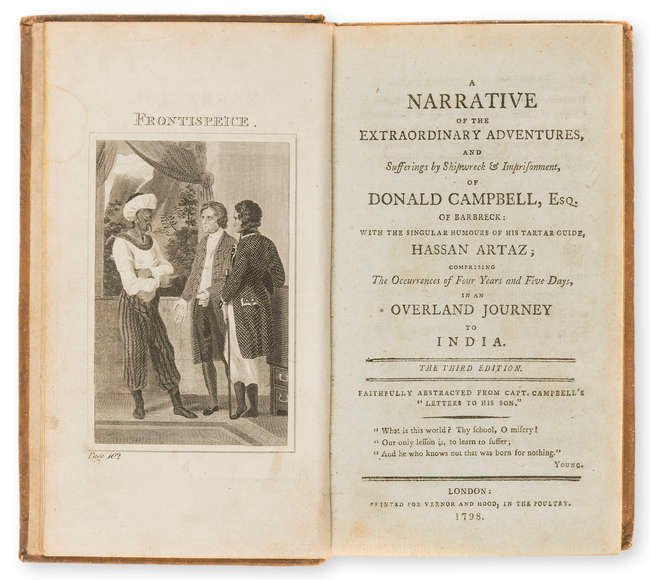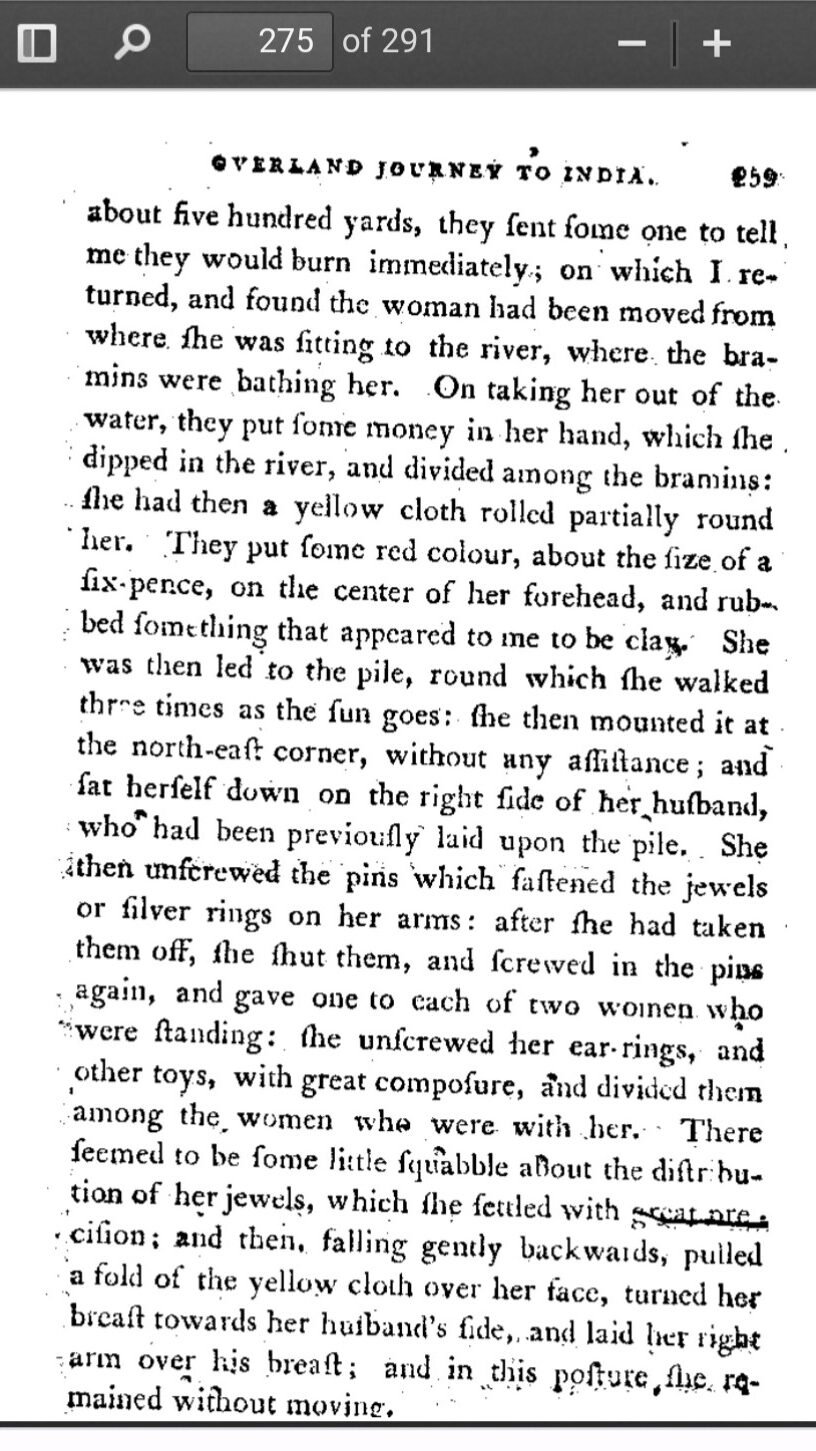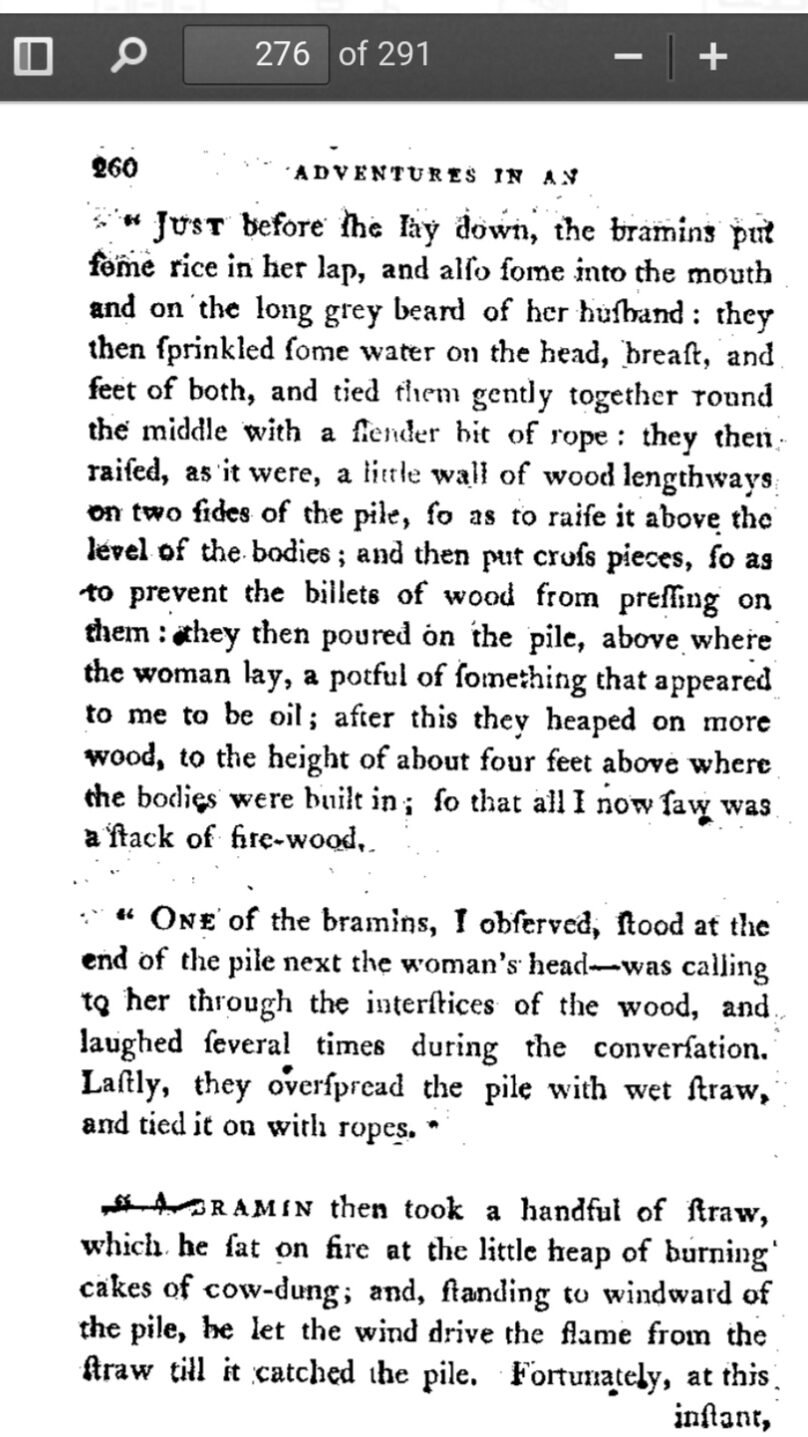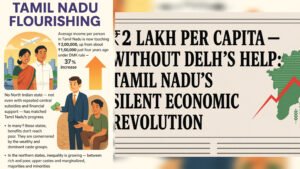STORY OF A CHILD WIDOW WHO WAS BURNED ALIVE
Disclaimer: This story is a retelling of a real life incident amounting to the death of a child widow.
Readers might find the content disturbing. Please take caution ⚠️
Mr. Donald Campbell, a European who came to Thanjavur in 1798, witnessed a scene where local people tied up a 15 years old child widow with her 60 years old husband’s dead body and burnt alive on (satimata) on fire.
A note on the Incident :
Muthukumar Sankaranarayanan Tuticorin:
An European named Donald Campbell embarks on a plan to discover India and is arrested halfway through the shipwreck and on the way to Indian shores. I read a collection of letters written by Campbell about his experiences after being imprisoned and freed, with the help of his friends and traveling around India.
I came across this book while looking for other information on the public website called Indian culture.
In this he has mentioned his traveling experiences from Travancore to Palayamkottai , Madurai, Trichy, Thanjavur, Nagapattinam and back to Chennai. The most important record in it is the mention of what he saw in Tanjore.
It was written in 1798. At that time, the Europeans did not identify Indians as Hindu but identified them as Gentoo. Europeans, sometimes arrogantly referred to us as Natives or as savages or black man. Just In the beginning he has referred to us as Gentoo. After that he has referred to us as Brahmin several times in his note. Since I was embarrassed to use it again and again I opted to avoid it.
BEFORE he left Tanjore, he had an opportunity of being an eye-witness to that extraordinary and horrid ceremony, the burning of a Gentoo woman with the body of her husband.
We shall transcribe Capt. Campbell’s account of the ceremony, as minuted down at the time it happenened.

Donald Campbell writes:
“THIS day, I went to see a Gentoo woman resign herself to be burned along with the corpse of her deceased husband.
The place fixed upon for this tragic scene was a small islet on the bank of one of the branches of the river Cavery, about a mile to the northward of the fort of Tanjore
“WHEN I came to the spot, I found the victim, who appeared to be not above sixteen, sitting on the ground, dressed in the Gentoo manner, with a white cloth wrapped round her, some white flowers like jasmines hanging round her neck, and some of them hanging from her hair. There were about twenty women sitting on their hands round her, holding a white handkerchief, extended horizontally over her head, to shade her from the sun, which was excessively hot, it being then about noon.
“AT about twenty yards from where he was sitting, and facing her, there were several brahmins busy in constructing a pile with billets of fire-wood: * the pile was about eight feet long, and four broad. They first began by driving some upright stakes into the ground, and then built up the middle to about the height of three feet and a half with billets of wood.
THE dead husband, who, from his appearance, seemed to be about sixty years of age, was lying close by, stretched out on a bier, made of bamboo canes. Four brahmins walked in procession three times round the dead body, first in a direction contrary to the sun, and afterwards other three times in a direction of the sun, all the while muttering incantations; and at each round or circuit they made, they untwisted, and immediately again twisted up, the small long lock of hair which was left un shaven at the back of their heads,
“SOME other brahmins were in the mean time employed in sprinkling water out of a green leaf, rolled up like a cup, upon a smaller heap of cakes of dry cow-dung, with which the pile was afterwards to be set on fire.”
“ An old brahmin sat at the north east corner , with a pair of spectacles on reading, the Chapter, or their scriptures, from a book composed of Cajan leaves.
“HAVING been present now nearly an hour, I enquired when they meant to set the pile on fire: they answered , in about two hours. As this spectacle was most melancholy, and naturally struck me with horror, and as I had only gone there to assure myself of the truth of such sacrifices being made, I went away towards the fort. After I had gone
about five hundred yards, they sent some one to tell, me they would burn immediately; on which I
returned, and found the woman had been moved from where she was sitting to the river, where the Brahmins were bathing her. On taking her out of the water, they put some money in her hand, which the dipped in the river, and divided among the brahmins: she had then a yellow cloth rolled partially round her. They put some red colour, about the size of a six-pence, on the center of her forehead, and rubbed something that appeared to me to be clay. She was then led to the pile, round which the walked three times as the sun goes: She then mounted it at the north-eaft corner, without assistance; and sat herself down on the right side of her husband, who had been previously laid upon the pile. She then unscrewed the pins which fastened the jewels or rings on her arms: after she had taken them off, the shut them, and screwed in the pins again, and gave one to each of two women who were standing: she unscrewed her earrings, and other jewels , with great composure, and divided them among the women who were with her. There seemed to be some little squabble about the distribution of her jewels, which the settled. She then, falling gently backwards, pulled a fold of the yellow cloth over her face, turned herself towards her husband’s side, and laid her right arm over his chest ; and in this posture, she remained without moving.
JUST before she lay down, the brahmins put some rice in her lap, and also some into the mouth and on the long grey beard of her husband: they then sprinkled some water on the head, chest, and feet of both, and tied them gently together round the middle with a rope: they then raised , as it were, a little wall of wood lengthways on two sides of the pile, so as to raise it above the level of the bodies; and then put cross pieces, so as to prevent the billets of wood from pressing on them they then poured on the pile, above where the woman lay, a potful of something that appeared to me to be oil; after this they heaped on more wood, to the height of about four feet above where the bodies were built in; so that all I now saw was a stack of fire-wood,
“ONE of the brahmins, I observed, stood at the end of the pile next the woman’s head-was calling to her through the interstices of the wood, and laughed several times during the conversation. Lastly, they overspread the pile with wet straw, and tied it on with ropes.
A BRAHMIN then took a handful of straw, which he set on fire at the little heap of burning cakes of cow-dung; and, standing to windward of the pile, he let the wind drive the flame from the straw till it caught the pile. Fortunately, at this instant, the wind rose much higher than it had been any part of the day; and in an instant the flames pervaded the whole pile, and it burnt with great fury. I listened a few seconds, but could not distinguish any shrieking , which might perhaps be owing to me being then to windward. In a very few minutes the pile became a heap of ashes.
“DURING the whole time of this process, which lasted from first to last above two hours before we lost sight of the woman, by her being built up in the middle of the pile, I kept my eyes almost constantly upon her; and I declare to God that I could not perceive, either in her countenance or limbs, the least trace of either horror, fear, or even hesitation her countenance was perfectly composed and placid; and she was not, I am positive , either intoxicated or stupefied. From several circumstances, I thought the brahmins exulted in this hell sacrifice, and did not seem at all displeased that Europeans should be witnesses of it.”
***
Compiled by We Dravidians Team
Source:http://www.indianculture.gov.in/rarebooks/narrative-extraordinary-adventures-and-sufferings-shipwreck-imprisonment-donald-campbell
Tamil Translation
1798 இல் தஞ்சாவூருக்கு வந்திருந்த திரு டொனால்டு கம்பெல் என்ற ஐரோப்பியர் அங்குள்ள ஊர் மக்கள் ஓர் இளம் பெண்ணை அவளது கணவனின் உடலோடு சேர்த்து கட்டி தீயிட்டு கொளுத்திய (சதிமாதா) காட்சியை நேரில் கண்டார். அது பற்றி அவர் எழுதிய டயரி குறிப்பு
Muthukumar Sankaran Tuticorin : Donald Campbell என்கிற ஐரோப்பியர் இந்தியாவைக் காணும் திட்டத்தில் கப்பல் ஏறி பாதி வழியில் கப்பல் உடைந்து ஒரு வழியாக கரையேறி கைது செய்யப்படுகிறார். சிறையில் அடைக்கப்பட்டு தம் நண்பர்களின் உதவியுடன் விடுதலையாகி பின் இந்தியாவைச் சுற்றி வந்து தன் அனுபவங்கள் பற்றி கேம்ப்பெல் எழுதிய கடிதங்களின் தொகுப்பை வாசித்தேன்.
இந்த நூல் Indian culture என்கிற பொது வலைதளத்தில் வேறு தகவல் தேடிய போது கண்ணில் பட்டது.
இதில் அவர் திருவிதாங்கூரில் இருந்து பாளையங்கோட்டை, மதுரை திருச்சி தஞ்சாவூர் நாகப்பட்டினம் வழியாக சென்னை சென்று திரும்பிய அனுபவங்களை குறிப்பிட்டிருக்கிறார். அதில் தஞ்சையில் அவர் பார்த்ததை குறிப்பிட்டு இருப்பது மிக முக்கியமான பதிவாகும். இது 1798ல் எழுதப்பட்டது. அப்போது இந்தியர்களை ஐரோப்பியர்கள் Hindu என்ற அடையாளப்படுத்தவில்லை Gentoo என்றே அடையாளப்படுத்தினார்கள். ஐரோப்பியர்கள் நம் மக்களை Natives என்றோ சிலசமயம் திமிராக savages என்றோ black man என்றோ குறிப்பிடுவார்கள். இதிலும் தொடக்கத்தில் மட்டும் Gentoo என்று குறிப்பிடுகிறார். அதன் பிறகு Brahmin என்ற வார்த்தையை இந்த குறிப்பில் நிறைய தடவை உபயோகப் படுத்தியுள்ளார். நான் தான் திரும்பத் திரும்ப உபயோகப்படுத்த சங்கடப்பட்டுக் கொண்டு விட்டு விட்டேன்.
“இந்துப் பெண் ஒருத்தி, இறந்து போன தன் கணவனோடு சேர்த்து எரிக்கப்பட விருந்த நிகழ்ச்சியைப் பார்க்கச் சென்றேன் இந்த வேதனைதரும் கொடிய சம்பவத்தை நிகழ்த்தத் தேர்ந்தெடுக்கப்பட்டிருந்த இடம் தஞ்சாவூர் கோட்டையிலிருந்து ஒருமைல் வடக்கே உள்ள காவிரி ஆற்றின் கரை
அந்தப் பெண்ணுக்கு 16 வயதிற்கு உள்ளே தான் இருக்கும் வெள்ளை சேலை கட்டி இருந்தாள். தலையிலும் கழுத்தைச் சுற்றிலும் வெள்ளை நிற மல்லிகை பூ சூடி இருந்தாள். அவளைச் சுற்றி 20 பெண்கள் நின்று கொண்டு ஒரு வெள்ளைத் துணியை அவள் தலைக்கு மேல் வெயில் படாமல் பிடித்துக் கொண்டிருந்தார்கள். அங்கிருந்து 20 அடி தள்ளி சில பிராமணர்கள் விறகுக் கட்டைகளால் எட்டடி நீளத்தில் நான்கடி அகலத்தில் சிதை தயாரித்துக் கொண்டிருந்தார்கள்.
முதலில் மூன்றடி உயரத்திற்கு கம்புகளை செங்குத்தாக நிறுத்தினார்கள் உள்ளே சிறிய மரத்துண்டுகளால் நிரப்பினார்கள்
பக்கத்தில் மூங்கில் கழிகளின் மேல் கிடத்தப்பட்டிருந்த இறந்தவருக்கு 60 வயதுக்கு மேல் இருக்கும். இறந்தவரின் உடம்பைச் சுற்றி நான்கு பிராமணர்கள் முதல் முறை சூரியனுக்கு எதிர் திசையாகவும் அடுத்த மூன்று முறை சூரிய ஒளி வீசும் திசையிலுமாக சுற்றி வந்தார்கள். இப்போது அவர்கள் தங்களுடைய நீண்ட தலைமுடியை அவிழ்த்து விட்டுக் கொண்டும் உடனே மீண்டும் முடிந்து கொண்டும் ஏதோ மந்திரங்களை உச்சரித்தார்கள்.
மற்றவர்கள் மந்திரம் சொல்லிக்கொண்டு கையில் இருந்த பச்சை இலையால் தண்ணீரை எடுத்து அருகில் குவித்து வைக்கப்பட்டிருந்த சாண எருக்களின் மீது தெளித்துக் கொண்டிருந்தார்கள். வடகிழக்கு மூலையில் அமர்ந்திருந்த ஒரு வயதானவர் கையில் இருந்த ஓலைச் சுவடியில் உள்ளதை வாசித்துக் கொண்டிருந்தார்.
அந்த சூழலின் அழுத்தமும் சோகமும் தாங்க முடியாமல் அருகில் இருந்தவரிடம் இன்னும் எவ்வளவு நேரம் நடக்கும் என்று கேட்டேன். இன்னும் இரண்டு மணி நேரத்திற்கு மேலாகும் என்று சொல்லவே நான் கோட்டையை நோக்கித் திரும்பினேன்.
500 கெஜ தூரம் நான் சென்றிருக்கும் பொழுது ஒருவர் என் பின்னாலேயே வந்து திரும்பி வருமாறு அழைத்தார். சடங்கு உடனே நடத்தப்பட இருப்பதாகச் சொன்னார்.
நான் சென்றபோது அந்தப் பெண்ணை மற்ற பெண்கள் அழைத்துச் சென்று ஆற்றில் குளிக்க வைத்துக் கொண்டிருந்தார்கள். அவள் நெற்றியில் செந்நிறத்தில் ஆறு பென்ஸ் காசு அளவுக்கு பொட்டு வைத்தார்கள். பிறகு ஈரமண் போன்று எனக்குத் தெரிந்த ஏதோ ஒன்றை பிசைந்து அவள் நெற்றியில் தடவினார்கள்.
பிறகு அந்தப் பெண் சிதைக்கு அழைத்து வரப்பட்டு அவள் சிதையைச் சுற்றி மூன்று தடவை நடந்தாள். சிதையில் அவள் கணவன் உடல் ஏற்கனவே ஏற்றி வைக்கப்பட்டிருந்தது. இவள் யாருடைய துணையும் இல்லாமல் தானாகவே அதில் ஏறி தன் கணவன் உடல்அருகில் அமர்ந்தாள்.
பிறகு தான் அணிந்திருந்த நகைகளின் திருகுகளை, திருகி கழற்றி அந்த ஆபரணங்களை கையில் எடுத்து மீண்டும் அந்த திருகுகளை பொருத்தி பக்கத்தில் நின்ற இரு பெண்களிடமும் ஆளுக்கு ஒன்றாக கொடுத்தாள். தன் காதில் அணிந்திருந்த ஆபரணங்களையும் அவள் மிகுந்த நிதானத்துடன் திருகை கழற்றி எடுத்து, மீண்டும் திருகை பொருத்தி அந்த பெண்களிடம் பிரித்துக் கொடுத்தார். பிரித்துக் கொடுக்கும் பொழுது ஏதோ சிறிய குழப்பம் ஏற்பட அவள் பொறுமையாக அதை சரியாகப் பிரித்துக் கொடுத்தாள்.
பிறகு மெதுவாக அப்படியே மல்லாக்க சாய்ந்து படுத்தாள் ஒரு மஞ்சள் துணியால் தன் முகத்தை மூடிய பிறகு புரண்டு தன் கணவருக்கு நெருக்கமாக படுத்து தன் வலதுகையை தூக்கி அவர் மார்பின் மீது வைத்தாள். அதன் பிறகு எந்த அசைவுமின்றி காத்திருந்தார்.
பிராமணர்கள் இறந்தவரின் வாயில் சிறிது அரிசியையும் மீதி அரிசியை அவள் மீதும் தூவினார்கள் பிறகு சிறிது நீரை இருவர் மீதும் தெளித்தார்கள். பிறகு ஒரு சிறிய கயிறு கொண்டு இருவரையும் சேர்த்துக் கட்டினார்கள். பிறகு இருவர் உடலும் மற்றவர் கண்களில் மறையும் அளவுக்கு மரக்கட்டைகளை சுற்றி அடுக்கினார்கள். குறுக்குவாக்கில் சிறிது கட்டைகளை அடுக்கிய பிறகு ஒரு பாத்திரத்தில் இருந்து எண்ணெய் போன்ற திரவத்தை அந்த பெண் இருந்த பகுதியில் ஊற்றினார்கள். பிறகு மீண்டும் கட்டையை அடுக்கினார்கள். இப்போது வெறும் விறகு குவியலாகவே எனக்குத் தெரிந்தது. இதே நேரத்தில் ஒரு பிராமணர் சிதைக்கு அருகே இருந்தவர் அந்தப் பெண்ணின் தலைப்பகுதி அருகே குனிந்து அவளை கூப்பிடுவது போல் சத்தம் கொடுத்தார். ஏதோ அவளிடம் சொல்வது போல சொல்லி பின் எல்லோரையும் பார்த்து சிரித்தார். பிறகு முழுவதுமாக வைக்கோலால் மூடினார்கள் சுற்றிலும் கயிறால் இறுக்கிக் கட்டினார்கள். பிறகு ஒருவர் சிறிது வைக்கோலை எடுத்து அருகில் கனன்று எரிந்து கொண்டிருந்த சாண எருக்களில் பற்ற வைத்து அதை சிதையில் போட்டார். பிறகு தீ நன்றாக பற்றுமாறு விசிறி விட்டார்கள். அப்போது காற்றும் அதே திசையில் வீச தீ வேகமாக பற்றி கொண்டது. ஏதோ ஒரு கிறீச்சிடும் ஒலியை நான் கேட்டது மாதிரியும் மற்ற இரைச்சலிடமிருந்து அதை தனிமைப்படுத்தி கேட்காதது மாதிரியும் இருந்தது. சில நிமிடங்களில் அந்த குவியல் சாம்பல் ஆனது.
நான் அந்த மொத்த நடவடிக்கைகளையும் கிட்டத்தட்ட இரண்டு மணி நேரம் பார்த்துக் கொண்டிருந்தேன் என் பார்வை முழுவதும் அந்தப் பெண்ணின் மீது தான் இருந்தது அவளிடம் எந்தவிதமான பயமோ பீதியோ எதிர்ப்புணர்வோ இல்லவே இல்லை மிக சாந்தமாகவும் நிதானமாகவும் இருந்தாள். அவளுக்கு ஏதேனும் மயக்க மருந்து கொடுத்திருப்பார்கள் என்று நான் நம்பவில்லை.
இந்த கொடூரமான சடங்கை நடத்தியவர்கள் அதை நிறைவேற்றியதில் பெருமிதம் கொண்டிருந்த மாதிரியும் ஐரோப்பியன் ஒருவன் அதைப் பார்த்துக் கொண்டிருப்பது அவர்களை எந்த விதத்திலும் பாதிக்கவில்லை என்பதும் கோட்டைக்கு திரும்பிய வழியில் என் சிந்தனையாக இருந்தது.”
Screenshots of original book:





Conclusion : It’s been nearly 250 years now, but still our hearts are heavy and our eyes are shedding tears while we read about this incident. The blood thirsty Brahmins should never be forgiven for all the brutal crimes they have committed in this society in the name of god and vedas since when they invaded our lands.







More Stories
From Pudukkottai to Parliament: M.M. Abdulla’s Voice for the Voiceless
2 Lakh Per Capita — Without Delhi’s Help: Tamil Nadu’s Silent Economic Revolution – Kathir RS
Sivaji came to Tamil Nadu to kill his brother & Loot the wealth of Tamil Nadu?